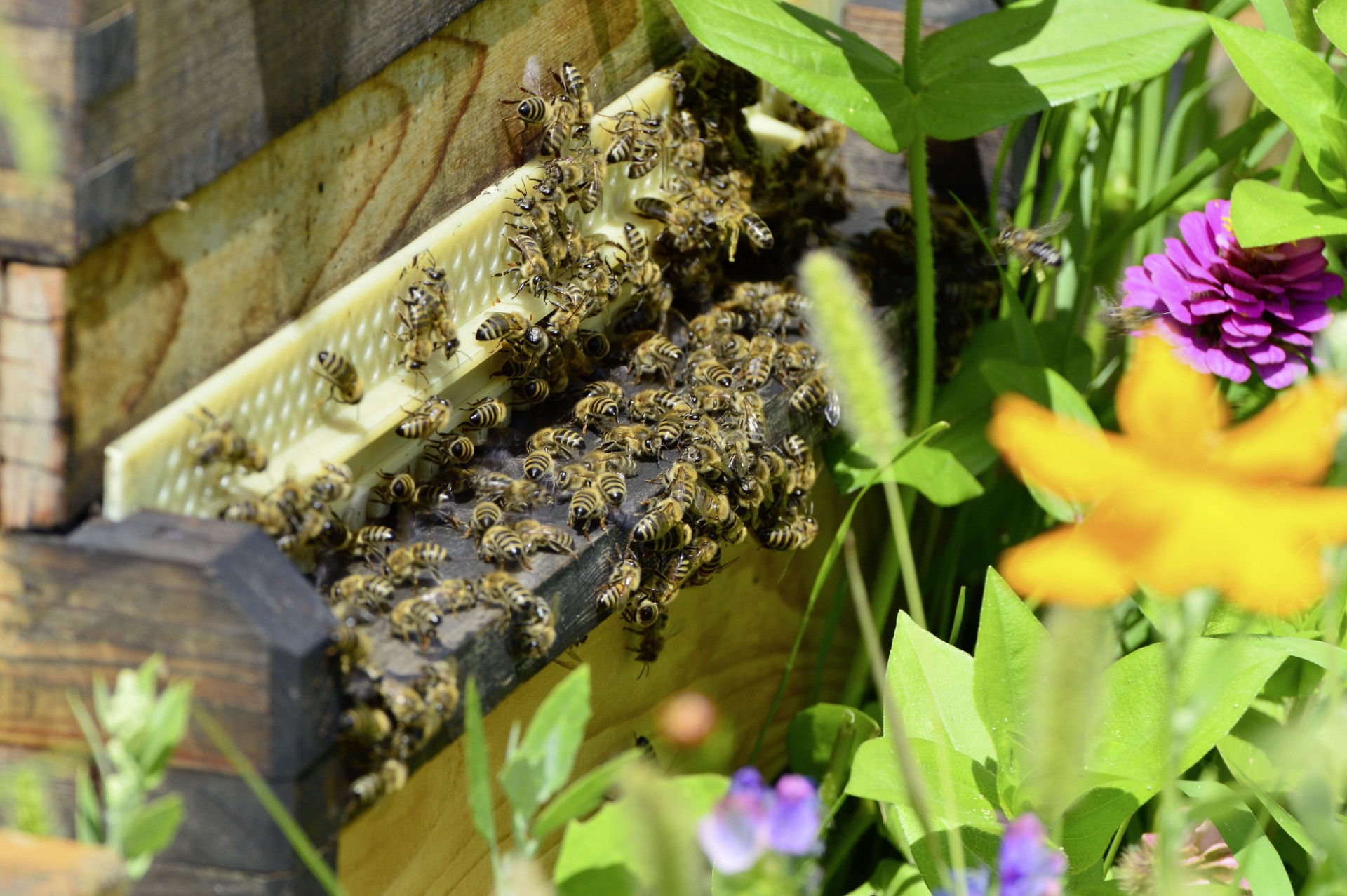Sources

Bees are fascinating creatures. They move strategically, play different roles within the hive, and follow a unique system that people, especially children, can learn from. Sadly, they are often the cause of fear and panic, which also discourages parents from introducing bees to their kids.
In this article, parents, educators, and caregivers will be able to dispel that fear by learning more about bees, their importance to the environment, how beekeeping works, and how they can safely introduce their children to the beautiful world of bees.
A Brief Overview of Bees
There is so much more to bees than being stinging honey producers. In fact, there are over 20,000 species of bees that exist in the world, which include honey bees, bumblebees, leafcutter bees, and carpenter bees—all of which have different characteristics. For instance, honey bees, which are known for their food-producing abilities, are a common bee type that beekeepers love to maintain.
Beekeeping, which is the practice of maintaining bees, has been around for thousands of years now, dating to around 8000 to 6000 BC when a cave painting of a “honey seeker” was found near Bicorp, Spain. At present, many people engage in beekeeping to collect honey, beeswax, or other products; pollinate crops; or sell bees to other beekeepers.
What’s most interesting about bees is that they live in a colony where every bee plays a key role. In particular, both honey bees and bumblebees work in different castes. There is a queen, male drones, and non-reproductive female workers. The queen lays eggs, drones mate with virgin queens, and workers maintain the hive.
There are a lot of things kids can learn from bees. They are not only known for their hard work, but they are also crucial pollinators of flowers, fruits, and vegetables.
The Buzz about Bees: How They Help the Environment
Bees are essential in keeping our biodiversity alive. Aside from being producers of honey, royal jelly, beeswax, propolis, and other products we enjoy today, they also contribute greatly to food security. According to the experts at the UN Food and Agriculture Organization, 35% of the world’s crop production depends on pollinators, including bees, birds, and bats.
Plant reproduction depends on pollination. The process kickstarts when a pollinator bee takes pollen from a flower’s anthers (a plant’s male part) and takes it to another flower’s stigma (a plant’s female part). This allows the plant to bear fruit and seeds. Bees are not often picky and, thus, are able to pollinate a large variety of flowers.
However, bee populations have been declining in many parts of the world due to harmful human activities, such as intensive farming, air pollution, and the excessive use of agrochemicals. Increasing temperatures due to climate change affect not only crop yields but also nutrition.
This great threat to bees also puts our food security at risk, as it means a decline in pollinators of coffee, almonds, apples, tomatoes, cocoa, and many more fruits and crops. Every effort to sustain bees is badly needed, which includes sharing as much knowledge about bees as possible with younger generations.
Beelieve It or Not: Debunking Common Bee Myths
There are many misconceptions about bees that discourage people from learning and interacting more with these wonderful creatures. Let’s debunk some of the most common ones.
Myth #1: All bees sting.
Truth: Not all bees can sting you. Only female bees have stingers, which can also be used to deposit eggs depending on the type of bee. But despite having a stinger, female bees do not usually sting unless provoked or if their nest is threatened.
Myth #2: All bees can sting repeatedly.
Truth: Not all bees are able to sting repeatedly; only bumblebees and honey bee queens can. Honey bee workers have barbed stingers and can only sting their victims once, as their stinger gets caught in the skin and detaches from their bodies. The stinger is crucial to the honey bee worker, which is why it dies after stinging. Meanwhile, honey bee queens can sting multiple times, as their stingers are smooth. Someone getting stung by a honey bee queen is rare, though. Honey bee queens mostly utilize their stingers to fight other queen bees.
Myth #3: All bees make honey.
Truth: Only honey bees and stingless bees can make an ample amount of honey. While bumblebees are also able to produce a small amount, it’s usually not enough to be worth harvesting. Since bumblebees have annual life cycles; they don’t usually survive through the winter and, thus, don’t prepare the honey for the cold months.
Myth #4: All bees work hard in the colony.
Truth: Not all bees put in the hard work. Not everyone in the colony is “as busy as a bee.” Workers usually do all the dirty work, such as rearing the young, feeding the queen, foraging, and maintaining the hive. Meanwhile, drones only have one task: mating with virgin bees.
Myth #5: Bees live a long time.
Truth: Worker bees, particularly those born during the spring or summer, only live up to 6 weeks. Those born in autumn usually live 20 weeks. Drones usually survive for up to 30 to 55 days. Meanwhile, bumblebee queens have an average life span of 1 to 2 years, while honey bee queens live up to 5 years.
Myth #6: All bees live in hives.
Truth: Not all types of bees live in hives, only the social ones. Solitary bees create individual nests, usually burrowed in the soil or on tree trunks.
Myth #7: Wasps are a type of bee.
Truth: Wasps are not a type of bee. While they have a similar shape, wasps have more contrasting yellow and black bands than bees’ light brown or brown-yellow color. Unlike bees, which are herbivores, young wasps are carnivorous, feeding on insects like beetles, crickets, and aphids.
Teaching Kids about Bees

Bees play a huge role in our ecosystem and must be protected, but they often get a bad rap among children. It is the role of the parent, educator, or caregiver to educate kids about them and to dispel common misconceptions surrounding these buzzing creatures.
Parents can get started on learning with their kids through the following tips:
Encourage interaction with nature
Immersing kids in nature is one way to develop compassion for the environment. Introducing them to the world of bees is one way to get them to appreciate nature and the creatures that live in it.
Enhance their scientific knowledge
From the life cycle of bees to the arduous process of honey production, everything about bees is an opportunity to teach science. Kids will not only learn about the fascinating life of bees, but they will also expand their scientific knowledge, gaining precious insights they can use in the future.
Nurture their sense of responsibility
Beekeeping is a fun activity that will help kids develop a sense of responsibility. When introducing them to the practice, they will learn how to be gentle when working around bees. Even the simple task of helping their parents through the process will make them more responsible adults in the future.
Perform creative activities
Teaching kids about bees can be challenging, but when done so in a fun, interactive manner, it’s likely to be a surefire success. The following tips are well worth the effort:
- Use visual aids. It may be difficult for kids to visualize how bees work. Showing them educational posters and photographs should do the trick.
- Bring relevant items. Tactile aids like a honeycomb piece, a beekeeper tool, or a single-frame observation hive can get kids more excited about beekeeping.
- Include fun games. Kids usually don’t have long attention spans. Having icebreakers and mini-games in between lessons will keep them engaged.
Hands-on Activities to Try with Kids
Once kids already have enough knowledge about bees, parents can take their lessons to the next level by observing live bees in action.
Scout for bees. A great thing about these creatures is that they can easily be found amongst flowers. Going for a bee walk is a great way for kids to see bees in their element as they go flower to flower.
Go to your local beekeeper. Kids will enjoy being up close and personal with real bees going about their day. They may even find themselves wanting to be beekeepers when they grow up.
Let them take a honey taste test. There are different types of honey, each of them having distinct tastes. Getting kids to describe each type is a fun and yummy way to teach them how bees convert nectar into what they are currently enjoying.
Do the waggle dance. Bees do a “waggle dance” to communicate the direction and distance of flowers to other bees in the colony. Dancing like bees do is a fun physical activity that kids will enjoy doing with their friends.
Bee Safety: Tips to Remember
Safety should always be a parent’s top priority when exposing their children to bees. To ensure a safe and smooth learning experience, the following practices can be followed:
- Stay away from colonies. When going on a bee walk, having a picnic, or camping, parents should remind kids that honey bees can nest anywhere that has holes, such as pipes or tree crevices. Let them avoid close contact with the colony as much as possible.
- Wear light-colored clothing. Bees may mistake individuals wearing dark colors as their natural predators (e.g., bears, skunks) and may show aggression towards them.
- Avoid wearing strong scents. Honey bees may be aggravated by citrus odors and other strong scents.
When faced with aggressive bees, ensure the following:
- Run away quickly. Parents may need to carry or assist their children when running. While doing so, they are advised to pull their shirt over their head to protect the sensitive parts of their face.
- Avoid flailing the arms. More movement will trigger the bees. Swatting a bee can also trigger a smell that will attract more bees.
- Run toward an enclosed shelter. It’s not advised to jump into water as bees will wait for that person to come up for air.
- When stung by a bee, parents should immediately remove all stingers. However, pulling it out with the fingers or a pair of tweezers is not recommended. Instead, they can scrape it out sideways with their fingernail or another straight-edged object.
Creating a Bee-Friendly World
The increasing decline in bees is a serious concern that kids should also know about. But they don’t have to be beekeepers and environmentalists to help save the bees in their own way.
One way families can protect the bees is by growing native plants in their gardens. Creating a flower garden filled with diverse colors, shapes, and bloom times is a bee’s paradise. Bees are also fond of flowering weeds and grasses, so it helps to let a part of the lawn grow without mowing.
Bees drink water, too, so creating a bee “pond” with kids is a great way to help bees thrive in nature. This may be as simple as filling a saucer with pebbles and water, so they have somewhere to land and be refreshed.
Bee Responsible
Bees are responsible for a third of the food that we eat; it is only right that we do our best to protect them. Parents, teachers, and caregivers are encouraged to help kids develop concern and compassion for these creatures by sharing vital information about them. By mixing fun and education, children will learn to appreciate these little workers of nature even more.
References:
- Bee Safety: USDA ARS. (n.d.). https://www.ars.usda.gov/pacific-west-area/tucson-az/carl-hayden-bee-research-center/docs/bee-safety/bee-safety/
- Bee Stings, BeeSpotter, University of Illinois. (n.d.). https://beespotter.org/topics/stings/
- Bee Waggle Dance. (n.d.). https://askabiologist.asu.edu/bee-dance-game/introduction.html
- Declining bee populations pose a threat to global food security and nutrition. (n.d.). https://www.fao.org/news/story/en/item/1194910/icode/
- How Long Do Bees Live? Life Expectancy By Species And Colony Role. (n.d.). BuzzAboutBees.net. https://www.buzzaboutbees.net/how-long-do-bees-live.html
- How many species of native bees are in the United States? | U.S. Geological Survey. (2020, July 23). https://www.usgs.gov/faqs/how-many-species-native-bees-are-united-states#:~:text=There%20are%20over%2020%2C000%20known,sized%20species%20of%20carpenter%20bees.
- How to treat a bee sting. (n.d.). https://www.aad.org/public/everyday-care/injured-skin/bites/treat-bee-sting
- Renfrewshire Communications team. (n.d.). The difference between wasps and bees - Renfrewshire Website. https://www.renfrewshire.gov.uk/article/3990/The-difference-between-wasps-and-bees
- Starting an Observation Hive of Honey Bees | Entomology. (n.d.). https://entomology.ca.uky.edu/ef700
- The Colony and Its Organization - Mid-Atlantic Apiculture Research and Extension Consortium. (2010, May 11). Mid-Atlantic Apiculture Research and Extension Consortium. https://canr.udel.edu/maarec/honey-bee-biology/the-colony-and-its-organization
- The Why, What, When, Where, Who, How of Pollination. (n.d.). Smithsonian Gardens. Retrieved March 9, 2023, from https://gardens.si.edu/gardens/pollinator-garden/why-what-when-where-who-how-pollination/
- U. (2023b, February 23). Man of Bicorp Cave Painting. Atlas Obscura. https://www.atlasobscura.com/places/man-of-bicorp-cave-painting
- World Bee Day. (n.d.). Food and Agriculture Organization of the United Nations. https://www.fao.org/world-bee-day/en/










